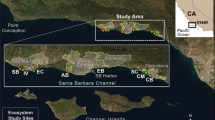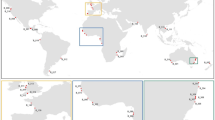Abstract
A numerical model detailing the functioning and emergent behaviour of an eroding coastal system is described. Model output from a 50-km study region centred on the soft-rock shore of northeast Norfolk was verified through comparison with cliff recession rates that were extracted from historical maps spanning more than a century. Predictions were then made for the period 2000 to 2100 under combined climatic change and management scenarios. For the scenarios evaluated, the model was relatively insensitive to increases in offshore wave height and moderately sensitive to changes in wave direction, but the most important effects were associated with accelerated sea-level rise (SLR). In contrast to predictions made using a modified version of the Bruun rule, the systems model predicted rather complex responses to SLR. For instance, on some sectors of coast, whereas the Bruun rule predicted increased recession under accelerated SLR, the systems model actually predicted progradation owing to the delivery of sediment from eroding coasts up-drift. By contrast, on coasts where beaches are underlain by shore platforms, both the Bruun rule and the systems model predicted accelerated recession rates. However, explicit consideration of the interaction between beach and shore platform within the systems model indicates that these coasts have a broader range of responses and lower overall vulnerability to SLR than predicted by the Bruun rule.
Similar content being viewed by others
References
Bray MJ, Hooke JM (1997) Prediction of coastal cliff erosion with accelerating sea-level rise. J Coast Res 13:453–467
Bruun P (1954) Coast erosion and development of beach profiles. In: Technical Memorandum no. 44, Beach Erosion Board, US Army Corps of Engineers
Bruun P (1962) Sea-level rise as a cause of shore erosion. J Waterw Harb Div ASCE 88:117–130
Burgess K, Townend I (2004) The impact of climate change upon coastal defence structures. In: 39th DEFRA Flood & Coastal Management Conference. 11.2.1–11.2.14
Cambers G (1976) Temporal scales in coastal erosion systems. Transactions of the Institute of British Geographers 1:246–256
Chang S-C, Evans G (1992) Source of sediment and sediment transport on the east coast of England: significant or coincidental phenomena? Mar Geol 107:283–288
Church JA, Gregory JM, Huybrechts P, Kuhn M, Lambeck K, Nhuan MT, Qin D, Woodworth PL (2001) Climate change 2001: the scientific basis. In: Intergovernmental Panel on Climate Change Third Assessment Report, Cambridge University Press
Church JA, White NJ, Coleman R, Lambeck K, Mitrovica JX (2004) Estimates of the regional distribution of sea level rise over the 1950–2000 period. J Climate 17:2609–2624
Clayton KM (1989) Sediment input from the Norfolk Cliffs, Eastern England – a century of coast protection and its effect. J Coast Res 5:433–442
Cooper JAG, Pilkey OH (2004) Sea-level rise and shoreline retreat: time to abandon the Bruun rule. Glob Planet Change 43:157–171
Cox J, Möller I (2002) Morphodynamics of large scale features on interrupted coasts. In: Human Interaction with Large-Scale Morphological Evolution (HUMOR), Report WP5
Dean RG (1991) Equilibrium beach profiles: characteristics and applications. J Coast Res 7:53–84
Dixon MJ, Tawn JA (1997) Estimates of extreme sea conditions. Proudman Oceanographic Laboratory. Report 112, p 217
EUROSION (2004) Living with coastal erosion in Europe: sediment and space for sustainability. European Commission, Directorate General Environment
Evans EP, Ashley R, Hall JW, Penning-Rowsell EC, Saul A, Sayers PB, Thorne CR, Watkinson A (2004) Foresight flood and coastal defence project: scientific summary: volume I, future risks and their drivers. Office of Science and Technology, London, p 366
Gregory JM, Church JA, Boer GJ, Dixon KW, Flato GM, Jackett DR, Lowe JA, O’Farrell SP, Roeckner E, Russell GL, Stouffer RJ, Winton M (2001) Comparison of results from several AOGCMs for global and regional sea-level change 1900–2100. Clim Dyn 18:225–240
Hall JW, Dawson RJ, Walkden MJA, Dickson ME, Stansby PS, Zhou J, Brown I, Watkinson A, Nicholls RJ (2005) Broad-scale analysis of morphological and climate impacts on coastal flood risk. In Proceedings of International Conference on Coastal Dynamics, Barcelona
Hanson H, Kraus NC (1989) GENESIS – Generalized model for simulating shoreline change, vol. 1: reference manual and users guide. In: Technical Report CERC-89-19, Coastal Engineering Research Center, p 247
HR Wallingford (2002a) Overstrand to Mundesley strategy study: hydrodynamics. HR Wallingford Ltd. Report
HR Wallingford (2002b) Overstrand to Mundesley strategy study: littoral sediment processes. HR Wallingford Ltd. Report
Hulme M, Jenkins GJ, Lu X, Turnpenny JR, Mitchell TD, Jones RG, Lowe J, Murphy JM, Hassell D, Boorman P, McDonald R, Hill S (2002) Climate change scenarios for the United Kingdom: The UKCIP02 Scientific Report. Tyndall Centre for Climate Change Research, UEA, Norwich
Kuang CP, Stansby PS (2004) Modelling directional random wave propagation inshore. Proc Inst Civ Eng, Water Marit Energy 157:123–131
Lee EM, Clark AR (2002) Investigation and management of soft rock cliffs. Thomas Telford, London
Miller L, Douglas BC (2004) Mass and volume contributions to twentieth-century global sea level rise. Nature 428:406–409
Nicholls RJ, Birkemeier WA, Lee G-H (1998) Evaluation of depth of closure using data from Duck, NC, USA. Mar Geol 148:179–201
Pelnard-Considere R (1956) Essai de theorie de l’evolution des forms de ravage en plage de sable et de galets. 4th Journees de l’Hydraulique, Les Energies de la Mer Question III:792–808
Pilkey OA, Cooper AG (2004) Society and sea level rise. Science 303:1781–1782
Posford Haskoning (2003) Winterton Dunes: Coastal Habitat Management Plan. Final Report
Shennan I, Horton B (2002) Holocene land- and sea-level changes in Great Britain. J Quat Sci 17:511–526
Shennan I, Lambeck K, Horton B, Innes J, Lloyd J, McArthur J, Rutherford M (2000) Holocene isostacy and relative sea-level changes on the east coast of England. Geographical Society, London, Special Publications 166:275–298
Shore Protection Manual (1984) U.S. Army Engineer Waterways Experiment Station, 4th ed. 2nd vol. US Government Printing Office, Washington, DC
Stive MJF (2004) How important is global warming for coastal erosion? Clim Change 64:27–39
Sunamura T (1992) Geomorphology of rocky coasts. Wiley, Chichester, p 302
Trenhaile AS (2004) Modeling the accumulation and dynamics of beaches on shore platforms. Mar Geol 206:55–72
Vincent CE (1979) Longshore sand transport rates – a simple model for the East Anglian coastline. Coast Eng 3:113–136
Walkden MJA, Dickson ME (2006) The response of soft rock shore profiles to increased sea-level rise. Tyndall Working Paper 97
Walkden MJA, Hall JW (2002) A model of soft cliff and platform erosion. In: Proceedings of the 28th International Conference on Coastal Engineering, Cardiff, pp 3333–3345
Walkden MJA, Hall JW (2005) A predictive mesoscale model of the erosion and profile development of soft rock shores. Coast Eng 52:535–563
Walkden MJA, Hall JW (in review) A mesoscale predictive model of the evolution and management of a soft rock coast. J Coast Res (accepted subject to revision, Nov 2006)
Zhang K, Douglas BC, Leatherman SP (2004) Global warming and coastal erosion. Clim Change 64:41–58
Author information
Authors and Affiliations
Corresponding author
Rights and permissions
About this article
Cite this article
Dickson, M.E., Walkden, M.J.A. & Hall, J.W. Systemic impacts of climate change on an eroding coastal region over the twenty-first century. Climatic Change 84, 141–166 (2007). https://doi.org/10.1007/s10584-006-9200-9
Received:
Accepted:
Published:
Issue Date:
DOI: https://doi.org/10.1007/s10584-006-9200-9




